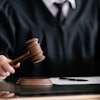
"If your actions inspire others to dream more, learn more, do more, and become more, you are a leader." -- John Quincy Adams
Keeping the team on track during a crisis requires leadership, focus, and a defined culture of the message you wish to convey to patients and the community.
 Dr. James Anderson.
Dr. James Anderson.Because of the COVID-19 pandemic, we have had to redefine and broaden our scope in sterilization, infection control, sanitation, and personal protective equipment (PPE) redesign. The media is alive with numbers and changing rules daily, and sometimes we must stop and take a breath and ask, "Why?" If we don't know the answer, how can we help our patients to understand?
There is little information in the public media about the safety of dental practices and the infection control guidelines to protect patients and employees. Recently, the tracking of COVID-19 infections' origination has shown few to no cases have been contracted in dental office environments. It seems that only dental people know this because the public may think otherwise. We are here to serve our patients by providing them with the best care in the safest healthcare environments. To do that, we must answer the "why" behind their fears, whether real or imaginary.
Now is the time to educate our patients about the necessity of routine preventive care to recover from COVID-19. It's not just about the teeth anymore. We have read that people are postponing necessary tests and treatment for significant health issues to avoid exposure to COVID-19. Some of these chronic illnesses (like heart disease and diabetes) are life-threatening, and monitoring the conditions should not be postponed because of fear of getting COVID-19. These same people are going to restaurants, stores, and businesses, thinking these locations are less dangerous than a medical or dental office.
According to recent findings from the U.S. Centers for Disease Control and Prevention (CDC), half of U.S. adults ages 30 years or older have periodontitis. This equals approximately 64.7 million U.S. adults. Think about that as some of the latest research from COVID-19 patients on ventilators and subsequent deaths shows that many have periodontal disease, and that its inflammation process contributes to respiratory failure and makes the COVID-19 condition worse.
Let's change the language describing a "routine" dental cleaning. Routine is defined as "a customary or regular course of procedure." If patients do not come in on their regular intervals, it is no longer a routine procedure. Irregular dental care can lead quickly to inflammation and infection of the teeth and supporting gingivae and bone. Patients who are postponing their regular prophy and come in a year later are still expecting the cleaning to be the same and at the same fee.
Proactive leadership would dictate that the patient is sent educational information about the progression of dental disease and how keeping regularly scheduled prophys is the key to total well-being and recovering from a severe life-threatening illness. Telling patients that they are "due for a cleaning" is no longer enough.
Through your practice website and patient contact software, send out the messages of safety protocols used and the concern for delaying dental care. Take a leadership role and make education a priority. You can also use the eAssist Dental Education Foundation at no charge to you or your patients. There are focused scientific articles regarding the health risks associated with dental care neglect.
Together we can change our patient's perception of the "routine cleaning" to be the essential healthcare visit of their lives.
Dr. James Anderson is a practicing dentist in Syracuse, UT, and is the CEO and founder of eAssist Dental Solutions. He can be reached via email.
The comments and observations expressed herein do not necessarily reflect the opinions of DrBicuspid.com, nor should they be construed as an endorsement or admonishment of any particular idea, vendor, or organization.


















